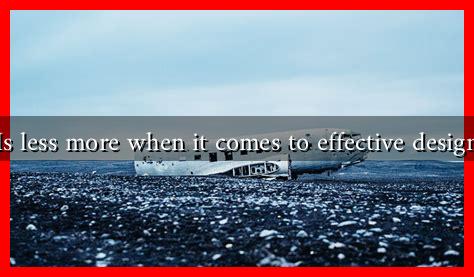-
Table of Contents
Is Less More When It Comes to Effective Design?
In the world of design, the phrase “less is more” has become a guiding principle for many professionals. This minimalist approach emphasizes simplicity, functionality, and clarity, often leading to more effective communication and user experiences. But is less truly more? This article explores the merits of minimalist design, supported by examples, case studies, and statistics, to determine its effectiveness in various contexts.
The Philosophy of Minimalism in Design
Minimalism in design is characterized by the removal of unnecessary elements, focusing instead on the essential components that convey a message or serve a purpose. This philosophy can be applied across various design disciplines, including graphic design, web design, product design, and architecture. The core tenets of minimalist design include:
- Simplicity: Stripping away excess to highlight the core message.
- Functionality: Ensuring that every element serves a purpose.
- Clarity: Enhancing user understanding and interaction.
Benefits of Minimalist Design
Adopting a minimalist approach can yield several benefits, particularly in enhancing user experience and improving communication. Here are some key advantages:
- Improved Focus: By reducing distractions, users can concentrate on the essential elements of a design. For instance, Apple’s product pages often feature clean layouts that allow users to focus on the product itself.
- Faster Load Times: In web design, minimalist sites tend to load faster due to fewer elements, which can significantly enhance user experience. According to Google, a one-second delay in mobile load times can lead to a 20% drop in conversion rates.
- Enhanced Usability: Simple designs are often more intuitive, making it easier for users to navigate and interact with the content. A study by the Nielsen Norman Group found that users prefer simple interfaces, which can lead to higher satisfaction rates.
Case Studies: Successful Minimalist Designs
Several brands have successfully implemented minimalist design principles, leading to increased engagement and customer satisfaction. Here are a few notable examples:
- Airbnb: The Airbnb website features a clean, user-friendly interface that allows users to search for accommodations without unnecessary distractions. This simplicity has contributed to its widespread popularity and ease of use.
- Google: The search engine’s homepage is famously minimalistic, with a simple search bar and few additional elements. This design choice has made it one of the most recognizable and effective websites globally.
- Muji: The Japanese retailer Muji embraces minimalism in its product design and branding. Their products are functional and aesthetically pleasing, reflecting the brand’s philosophy of simplicity.
Challenges of Minimalist Design
While there are many advantages to minimalist design, it is not without its challenges. Some potential drawbacks include:
- Over-Simplification: Stripping away too many elements can lead to a lack of context or information, leaving users confused.
- Brand Identity: For some brands, a minimalist approach may not align with their identity or target audience, potentially alienating customers.
- Creativity Constraints: Minimalism can sometimes stifle creativity, as designers may feel limited in their ability to express ideas through elaborate visuals.
Conclusion: Finding the Balance
In conclusion, the principle of “less is more” holds significant value in effective design, particularly when it enhances user experience and communication. Minimalist design can lead to improved focus, faster load times, and enhanced usability, as evidenced by successful case studies from brands like Airbnb and Google. However, designers must also be cautious of the potential pitfalls of over-simplification and ensure that their designs align with brand identity and user needs.
Ultimately, the key takeaway is that effective design is about finding the right balance between simplicity and functionality. By thoughtfully applying minimalist principles, designers can create impactful experiences that resonate with users while still conveying the intended message. For further reading on minimalist design, consider exploring resources from Smashing Magazine.

